Read and download free pdf of CBSE Class 11 Accountancy Financial Statements II Worksheet Set A. Students and teachers of Class 11 Accountancy can get free printable Worksheets for Class 11 Accountancy Chapter 9 Financial Statements - II in PDF format prepared as per the latest syllabus and examination pattern in your schools. Class 11 students should practice questions and answers given here for Accountancy in Class 11 which will help them to improve your knowledge of all important chapters and its topics. Students should also download free pdf of Class 11 Accountancy Worksheets prepared by teachers as per the latest Accountancy books and syllabus issued this academic year and solve important problems with solutions on daily basis to get more score in school exams and tests
Worksheet for Class 11 Accountancy Chapter 9 Financial Statements - II
Class 11 Accountancy students should download to the following Chapter 9 Financial Statements - II Class 11 worksheet in PDF. This test paper with questions and answers for Class 11 will be very useful for exams and help you to score good marks
Class 11 Accountancy Worksheet for Chapter 9 Financial Statements - II
Short Answer Type Questions :
Question: Consider the following extract of trial balance from books of Prateek Limited.

Adjustment Charge ₹ 6,000 as interest on drawings.
Pass an adjusting entry and show effect on financial statements.
Answer: Adjustment Entries
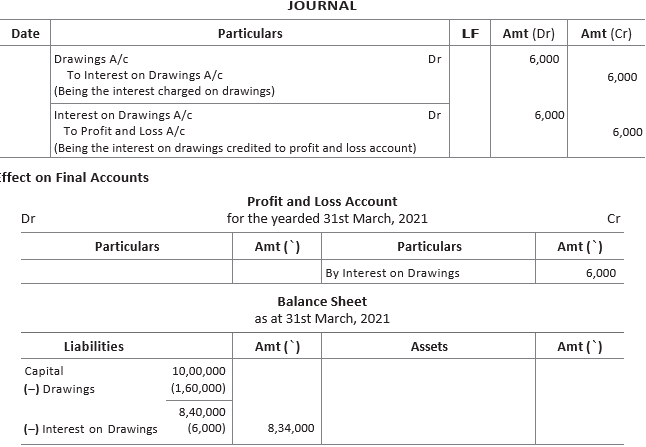
Question: Consider the following extract of trial balance taken from Prakhar’s Books

Additional Information
Rent received but not earned ₹ 1,200.
Pass an adjusting entry and show how will this appear in final accounts.
Answer: Adjustment Entry
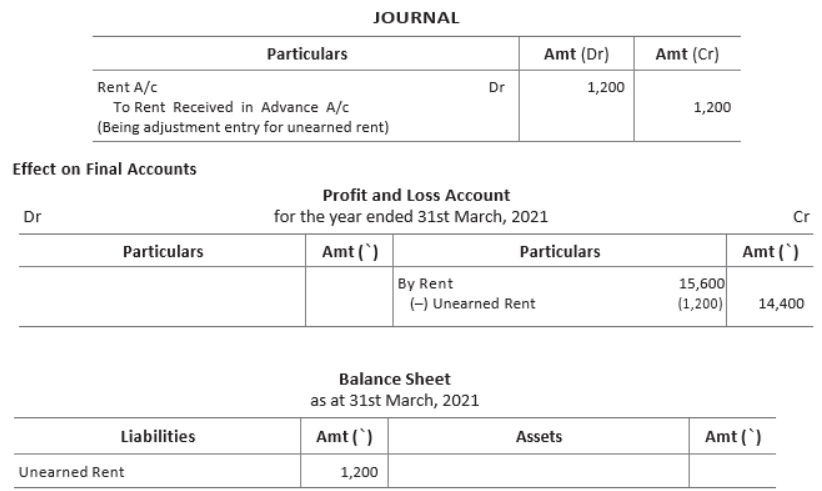
Question: What is meant by closing stock? Show its treatment in final accounts.
Answer: Closing stock implies the value of unsold goods at the end of an accounting period. Closing stock is valued at cost or net realisable value, whichever is lower.
If closing stock is given in adjustment, it will be shown on the credit side of trading account and will also be shown on the assets side of balance sheet under current assets. If closing stock is given in trial balance, it will only be shown on the assets side of balance sheet under current assets.
Question: The net profit of a firm amounts to ₹ 31,500 before charging commission. The manager of the firm is entitled to a commission of 5% on the net profits. Calculate the commission payable to the manager in each of the following alternative cases and also show its effect on final accounts.
(i) If the manager is allowed commission on the net profit before charging such commission.
(ii) If the manager is allowed commission on the net profit after charging such commission.
Also, show its treatment in final accounts ending on 31st March, 2021.
Answer:
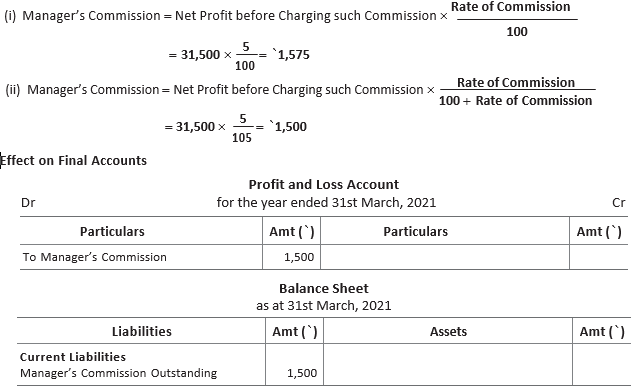
Question: Consider the following extract of trial balance taken from books of Mehta Limited.

Additional Information
During the year, the proprietor, Mr Mehta withdrew goods worth ₹ 5,000.
Pass an adjusting entry and show effect on financial statements.
Answer: Adjusting Entry
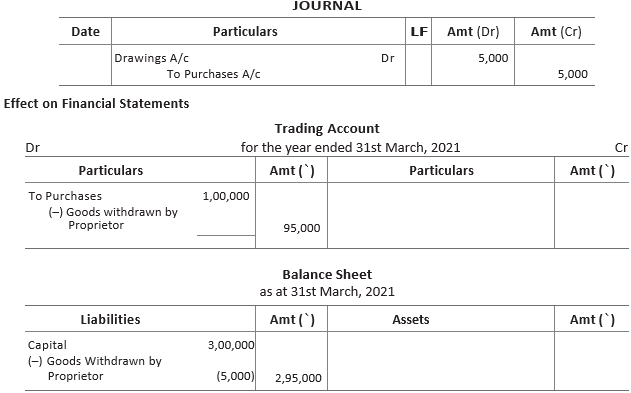
Question: What is meant by provision for doubtful debts? Why is it necessary to create a provision for doubtful debts at the time of preparation of final accounts?
Answer: The provision for doubtful debts is estimated amount of bad debts that will arise from amount receivable from debtors. In order to bring an element of certainty in amount of debtors, a provision for doubtful debts is created to cover the loss of possible bad debts as per the principle of prudence or conservatism.
Question: Consider the following extract of trial balance of ABC Limited

Adjustment Interest on Kartik’s loan is due to be received @ 12% per annum for the whole year.
Pass an adjusting entry and show effect on financial statements.
Answer: Adjustment Entries

Working Note
Interest of Loan = 16,000 ×12/100 = ₹ 1,920
Effect on Final Accounts
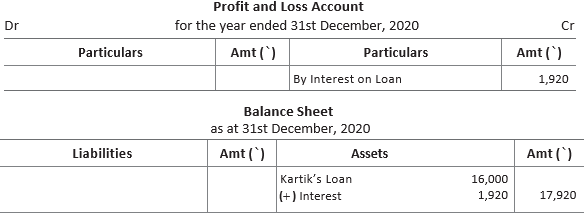
Question: Consider the following extract of trial balance taken from books of Harshit Enterprises.

Additional Information
(i) Write-off further bad debts ₹ 6,000.
(ii) Provision for doubtful debts to be maintained at 5% on sundry debtors.
(iii) Create a provision for discount on sundry debtors at 3%.
Show effect on profit and loss account and balance sheet.
Answer: Effect on Final Acccounts
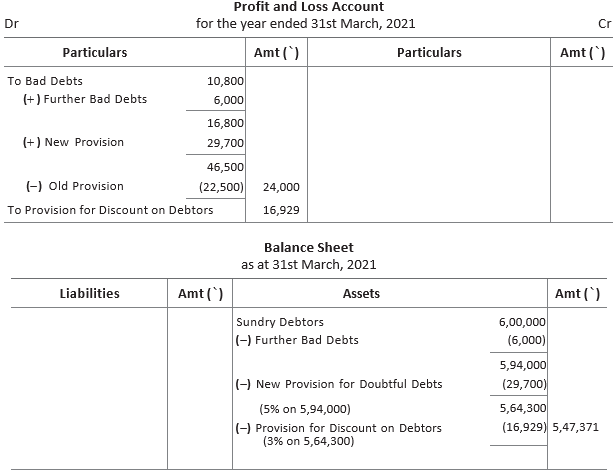
Question: Following trial balance is prepared on 31st March, 2019 from a trader’s book
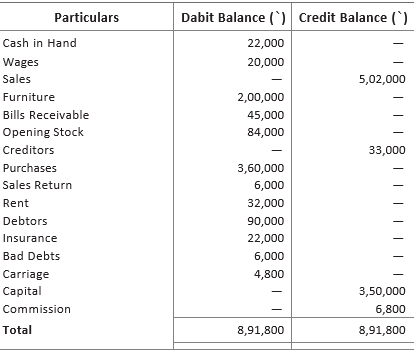
Taking into consideration the adjustments given below. Pass the journal entries for the same.
(i) Closing stock ₹ 1,00,000
(ii) Outstanding rent ₹ 4,200 and outstanding wages ₹ 9,000
(iii) Prepaid insurance ₹ 7,900 and accrued commission ₹ 1,200
(iv) Charge depreciation on furniture @ 10% p.a.
Answer:
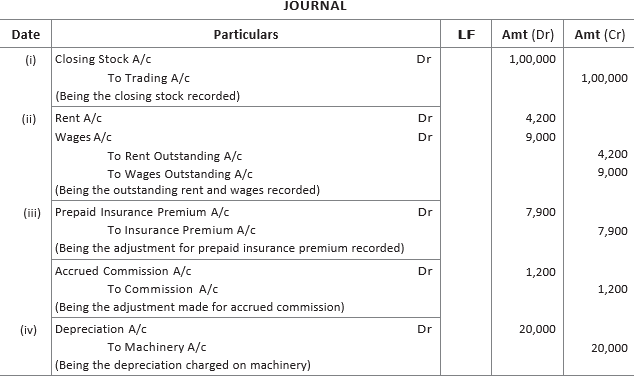
Working Note
Depreciation of Machinery = 2,00,000 ×10/100 = ₹ 20,000
Question: What are the adjusting entries? Why are they necessary for preparing final accounts?
Or
Why is it necessary to record the adjusting entries in the preparation of final accounts?
Answer: It is the entry passed to record expenses and incomes that relate to the accounting period but are yet to be paid or received.
The need of making various adjustments are stated below
(i) To ascertain the true profit or loss of the business.
(ii) To determine the true financial position of the business.
(iii) To make a record of the transactions earlier omitted in the books.
(iv) To rectify the errors committed in the books.
(v) To complete the incomplete transactions.
Question: Consider the following extract of trial balance

Additional Information
Commission earned but not received ₹ 1,800.
Pass an adjusting entry and show how will this appear in final accounts.
Answer: Adjustment Entry
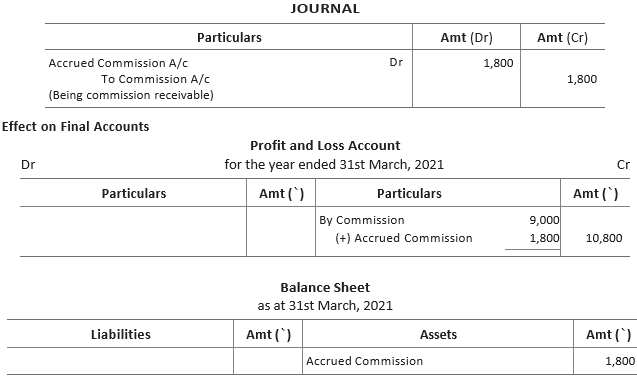
Question: Consider the following extract of trial balance taken from books of Manisha Enterprises.

Additional Information
(i) Credit sales of ₹ 9,000 were not recorded in books of accounts.
(ii) Received ₹ 98,000 worth of goods on 29th March, 2020 but the invoice of purchases was not recorded.
Answer:
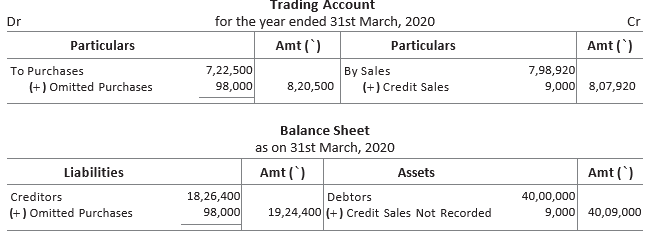
Question: State the meaning of
(i) Outstanding expenses
(ii) Prepaid expenses
(iii) Income received in advance
Answer: (i) Outstanding Expenses Those expenses whose benefit have been derived during the current year but payment is not made at the end of the year are known as outstanding expenses.
(ii) Prepaid Expenses Those expenses which have been paid in current year but the benefit of which will be available in the next accounting year are known as prepaid expenses.
(iii) Income Received in Advance The income or portion of income which is received during the current accounting year but has not been earned is called unearned income.
Question: Consider the following trial balance of Rohan Limited.

Additional Information
During the year the proprietor, Mr Rohan distributed goods worth ₹ 10,000 as free samples.
Pass an adjusting entry and show effect on financial statements.
Answer: Adjusting Entry
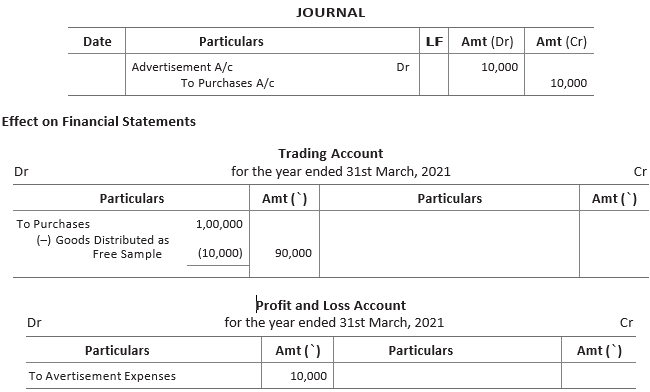
Long Answer Type Questions :
Question: Prepare a trading and profit and loss account for the year ending 31st December, 2020 from the balances extracted from M/s Rahul and Sons. Also prepare a balance sheet at the end of the year.
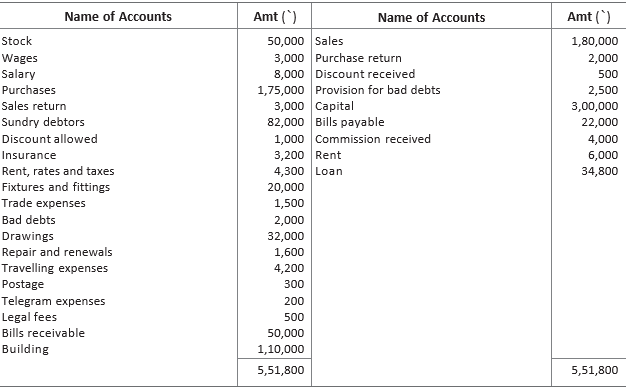
Adjustments
(i) Commission received in advance ₹ 1,000.
(ii) Rent received ₹ 2,000.
(iii) Salary outstanding ₹ 1,000 and insurance prepaid ₹ 800.
(iv) Further bad debts ₹ 1,000 and provision for bad debts@5% on debtors and discount on debtors@2%.
(v) Closing stock ₹ 32,000.
(vi) Depreciation on building @ 6% p.a.
Answer:
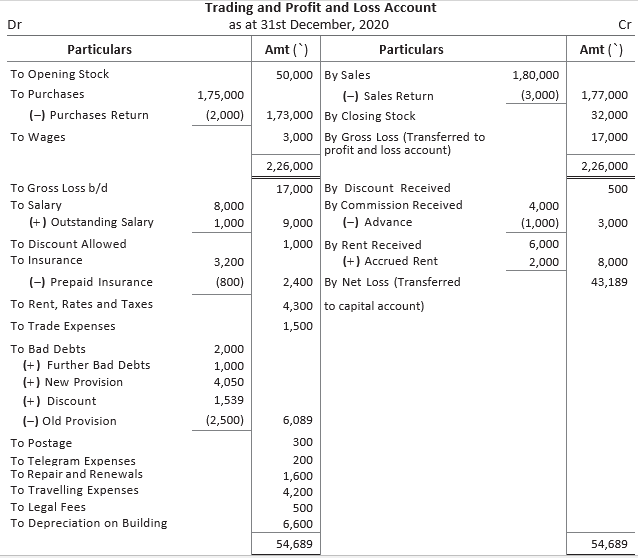
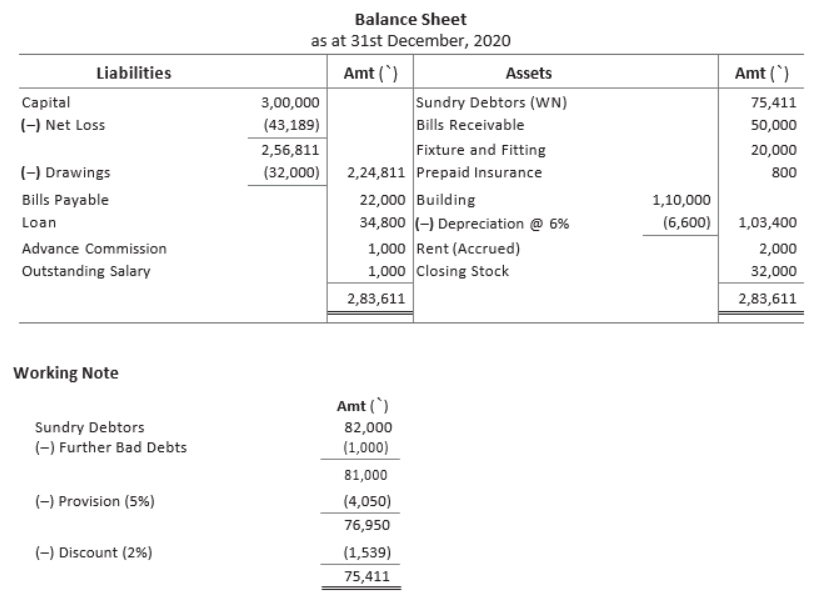
Question: The following is the trial balance of Mr Chidambram on 31st March, 2020.
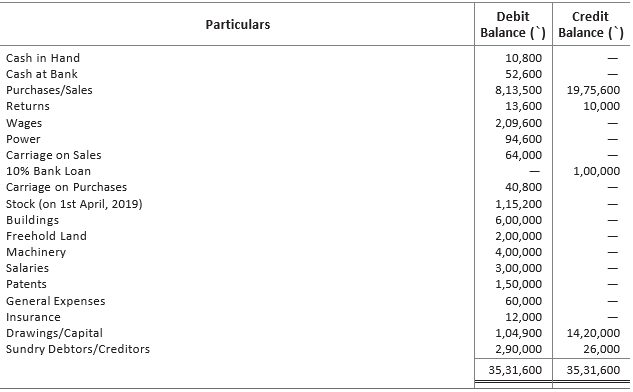
Taking into account the following adjustments, prepare trading and profit and loss account and the balance sheet.
(i) Stock in hand on 31st March, 2020 is ₹ 1,36,000.
(ii) Machinery is to be depreciated at the rate of 10% p.a. and patent at the rate of 20% p.a.
(iii) Salaries for the month of March, 2020 amounting to ₹ 30,000 were unpaid.
(iv) Insurance includes a premium of ₹ 1,700 for 2020-21.
(v) Wages include a sum of ₹ 40,000 spent on the erection of a cycle shed for employees and customers.
(vi) A provision for doubtful debts is to be created to the extent of 5% on sundry debtors.
(vii) Bank loan was taken on 1st October, 2019.
Answer:
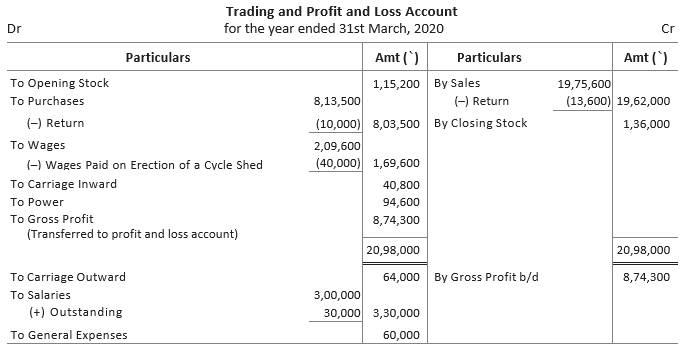
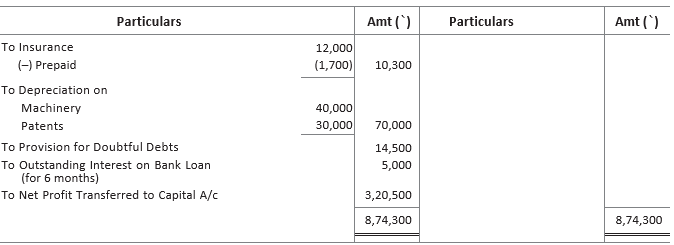
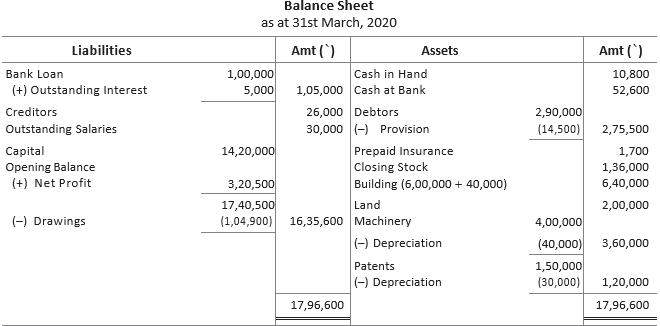
Question: From the books of M/s Aggarwal, the following trial balance has been prepared on 31st March, 2020
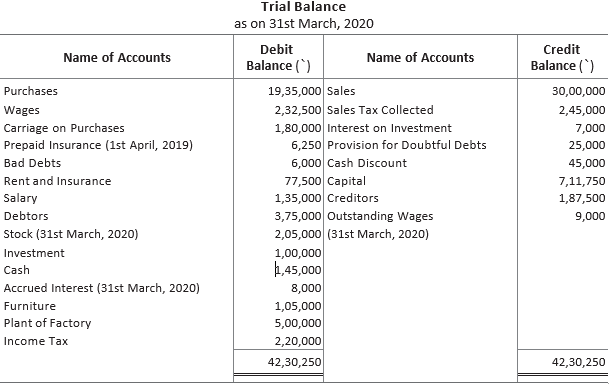
Prepare the trading and profit and loss account for the year ended 31st March, 2020 and the balance sheet as at that date, taking into consideration the adjustments given below
(i) On 1st October, 2019, plant worth ₹ 1,00,000 was purchased on credit but no entry has been passed.
(ii) Outstanding expenses rent ₹ 5,000 and salary ₹ 6,000.
(iii) Prepaid expenses insurance ₹ 2,500 and wages ₹ 4,000.
(iv) Goods worth ₹ 27,500 were taken for personal use by the owner but no entry has been made.
(v) Write-off depreciation on plant and furniture @ 10% p.a.
(vi) Write-off ₹ 5,000 from debtors as bad debts and create provision for doubtful debts @ 5% and 2% provision for discount on debtors.
Answer:

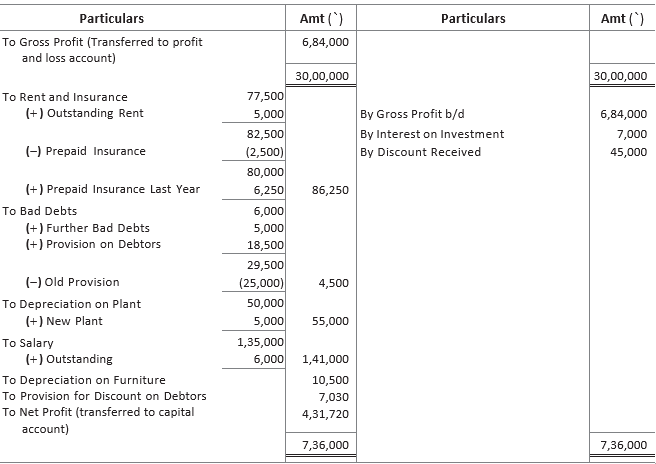
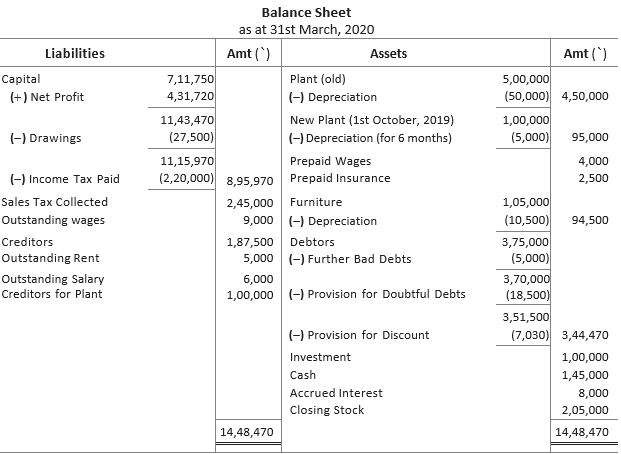
Question: From the following trial balance of Sh. Prakash, prepare trading and profit and loss account for the year ended 31st March, 2020 and balance sheet as at that date.
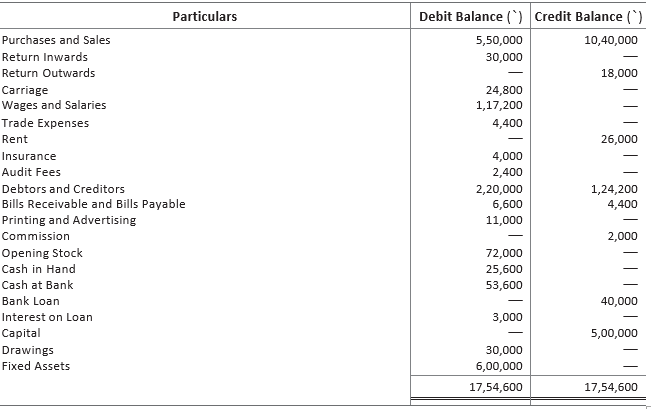
Additional Information
(i) Stock at the end₹1,20,000. (ii) Depreciation to be charged on fixed assets @10%.
(iii) Commission earned but not received amounting to ₹ 800.
(iv) Rent received in advance ₹ 2,000.
(v) 8% interest to be allowed on capital and ₹ 1,800 to be charged as interest on drawings.
Answer:
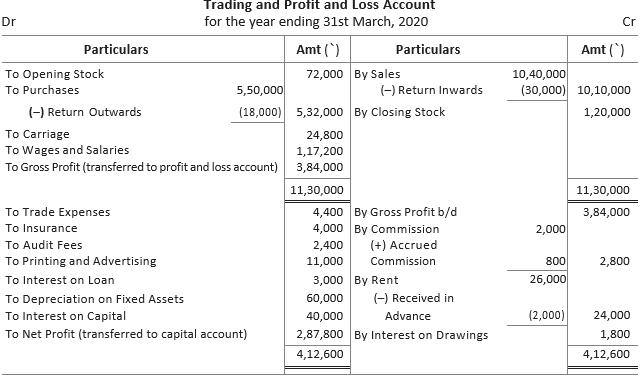
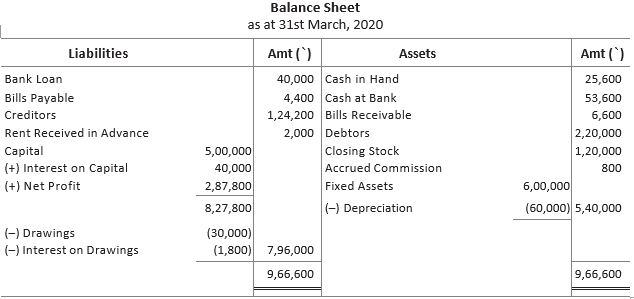
Question: From the following ledger balances of Mr Navjot Singh, prepare the trading and profit and loss account for the year ended 31st March, 2020 and the balance sheet as at that date after making the necessary adjustments.
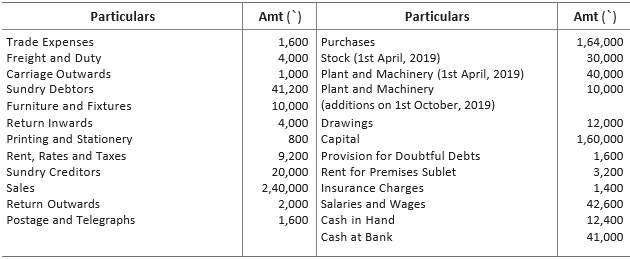
Additional Information
(i) Stock on 31st March, 2020 was ₹ 28,000.
(ii) Write-off ₹ 1,200 as bad debts.
(iii) Provision for doubtful debts is to be maintained @ 5%.
(iv) Provision for depreciation on furniture and fixtures at 5% p.a. and on plant and machinery at 20% p.a.
(v) Insurance prepaid was ₹ 200.
(vi) A fire occurred in the godown and stock of the value of ₹ 10,000 was destroyed. It was insured and the insurance company admitted full claim.
Answer:
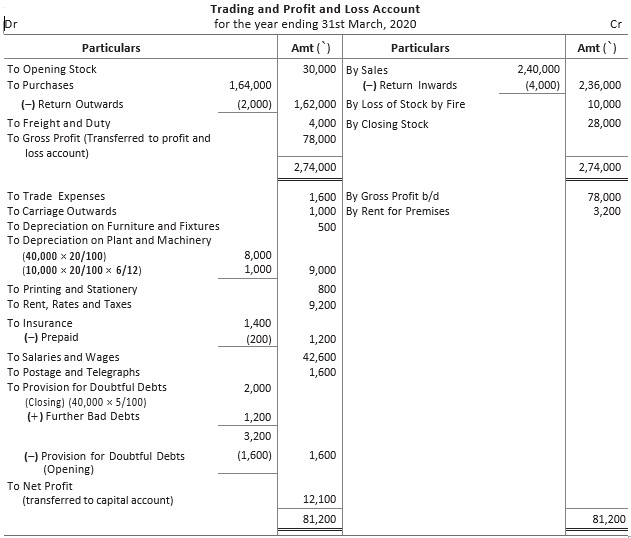
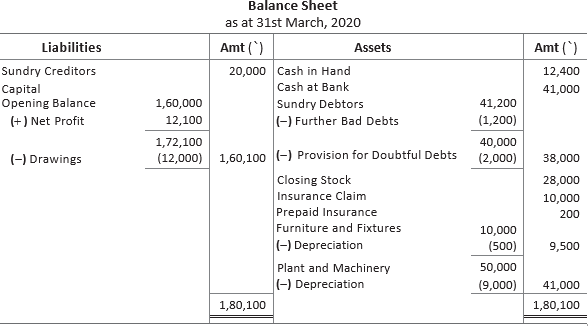
Note – Sometimes, the balance in the provision for doubtful debts account is more than sufficient to meet the bad debts and the new provision required. Thus, remaining amount is then credited to the profit and loss account.
Question: Following balances have been extracted from the trial balance of M/s Keshav Electronics Ltd. You are required to prepare the trading and profit and loss account and balance sheet as on 31st December, 2019.
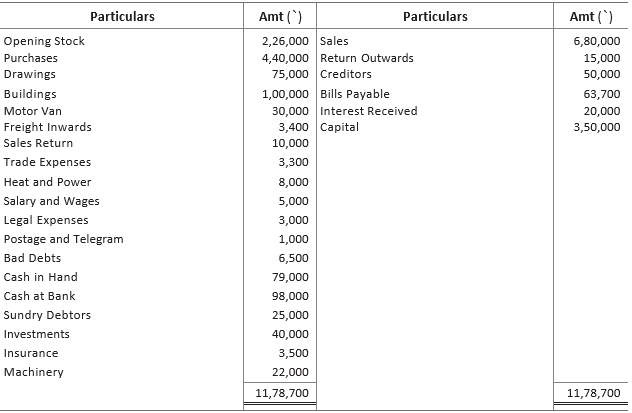
The following additional information is available
(i) Stock on 31st December, 2019 was ₹ 30,000.
(ii) Depreciation is to be charged on building @ 5% and motor van @ 10%.
(iii) Provision for doubtful debts is to be maintained @ 5% on sundry debtors.
(iv) Unexpired insurance was ₹ 600.
(v) The manager is entitled to commission @ 5% on net profit after charging such commission.
Answer:
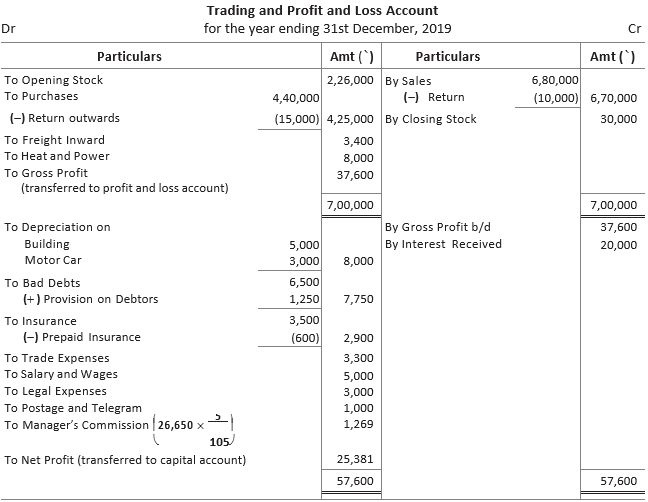
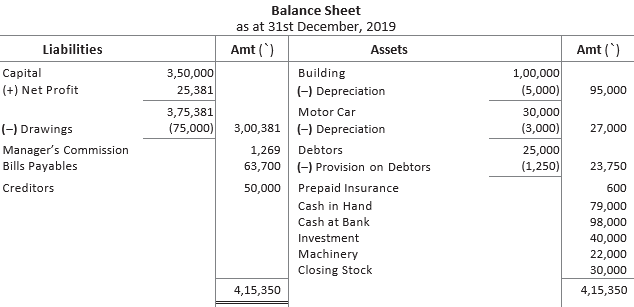
| CBSE Class 11 Accountancy Theory Base Of Accounting Enrichment Worksheet |
| CBSE Class 11 Accountancy Theory Base Of Accounting Worksheet |
| CBSE Class 11 Accountancy Subsidiary Books I Cash Book Worksheet |
| CBSE Class 11 Accountancy Subsidiary Books II Other Books Worksheet |
| CBSE Class 11 Accountancy Bank Reconciliation Statement Worksheet |
| CBSE Class 11 Accountancy Question Bank Worksheet |
| CBSE Class 11 Accountancy Rectification Of Errors Worksheet Set A |
| CBSE Class 11 Accountancy Rectification Of Errors Worksheet Set B |
| CBSE Class 11 Accountancy Depreciation Provisions And Reserves Worksheet |
| CBSE Class 11 Accountancy Financial Statements Worksheet Set A |
| CBSE Class 11 Accountancy Financial Statements Worksheet Set B |
| CBSE Class 11 Accountancy Financial Statements II Worksheet Set A |
Worksheet for CBSE Accountancy Class 11 Chapter 9 Financial Statements - II
We hope students liked the above worksheet for Chapter 9 Financial Statements - II designed as per the latest syllabus for Class 11 Accountancy released by CBSE. Students of Class 11 should download in Pdf format and practice the questions and solutions given in the above worksheet for Class 11 Accountancy on a daily basis. All the latest worksheets with answers have been developed for Accountancy by referring to the most important and regularly asked topics that the students should learn and practice to get better scores in their class tests and examinations. Expert teachers of studiestoday have referred to the NCERT book for Class 11 Accountancy to develop the Accountancy Class 11 worksheet. After solving the questions given in the worksheet which have been developed as per the latest course books also refer to the NCERT solutions for Class 11 Accountancy designed by our teachers. We have also provided a lot of MCQ questions for Class 11 Accountancy in the worksheet so that you can solve questions relating to all topics given in each chapter.
You can download the CBSE Printable worksheets for Class 11 Accountancy Chapter 9 Financial Statements - II for latest session from StudiesToday.com
There is no charge for the Printable worksheets for Class 11 CBSE Accountancy Chapter 9 Financial Statements - II you can download everything free
Yes, studiestoday.com provides all latest NCERT Chapter 9 Financial Statements - II Class 11 Accountancy test sheets with answers based on the latest books for the current academic session
CBSE Class 11 Accountancy Chapter 9 Financial Statements - II worksheets cover all topics as per the latest syllabus for current academic year.
Regular practice with Class 11 Accountancy worksheets can help you understand all concepts better, you can identify weak areas, and improve your speed and accuracy.

